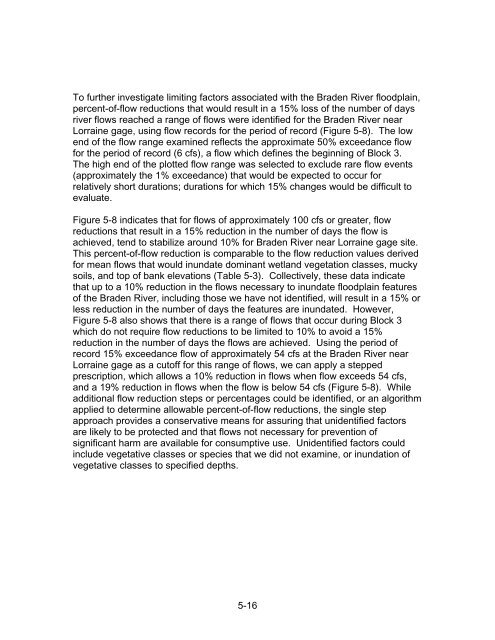Chapter 1 Minimum Flows and Levels - Southwest Florida Water ...
Chapter 1 Minimum Flows and Levels - Southwest Florida Water ...
Chapter 1 Minimum Flows and Levels - Southwest Florida Water ...
You also want an ePaper? Increase the reach of your titles
YUMPU automatically turns print PDFs into web optimized ePapers that Google loves.
To further investigate limiting factors associated with the Braden River floodplain,<br />
percent-of-flow reductions that would result in a 15% loss of the number of days<br />
river flows reached a range of flows were identified for the Braden River near<br />
Lorraine gage, using flow records for the period of record (Figure 5-8). The low<br />
end of the flow range examined reflects the approximate 50% exceedance flow<br />
for the period of record (6 cfs), a flow which defines the beginning of Block 3.<br />
The high end of the plotted flow range was selected to exclude rare flow events<br />
(approximately the 1% exceedance) that would be expected to occur for<br />
relatively short durations; durations for which 15% changes would be difficult to<br />
evaluate.<br />
Figure 5-8 indicates that for flows of approximately 100 cfs or greater, flow<br />
reductions that result in a 15% reduction in the number of days the flow is<br />
achieved, tend to stabilize around 10% for Braden River near Lorraine gage site.<br />
This percent-of-flow reduction is comparable to the flow reduction values derived<br />
for mean flows that would inundate dominant wetl<strong>and</strong> vegetation classes, mucky<br />
soils, <strong>and</strong> top of bank elevations (Table 5-3). Collectively, these data indicate<br />
that up to a 10% reduction in the flows necessary to inundate floodplain features<br />
of the Braden River, including those we have not identified, will result in a 15% or<br />
less reduction in the number of days the features are inundated. However,<br />
Figure 5-8 also shows that there is a range of flows that occur during Block 3<br />
which do not require flow reductions to be limited to 10% to avoid a 15%<br />
reduction in the number of days the flows are achieved. Using the period of<br />
record 15% exceedance flow of approximately 54 cfs at the Braden River near<br />
Lorraine gage as a cutoff for this range of flows, we can apply a stepped<br />
prescription, which allows a 10% reduction in flows when flow exceeds 54 cfs,<br />
<strong>and</strong> a 19% reduction in flows when the flow is below 54 cfs (Figure 5-8). While<br />
additional flow reduction steps or percentages could be identified, or an algorithm<br />
applied to determine allowable percent-of-flow reductions, the single step<br />
approach provides a conservative means for assuring that unidentified factors<br />
are likely to be protected <strong>and</strong> that flows not necessary for prevention of<br />
significant harm are available for consumptive use. Unidentified factors could<br />
include vegetative classes or species that we did not examine, or inundation of<br />
vegetative classes to specified depths.<br />
5-16
















